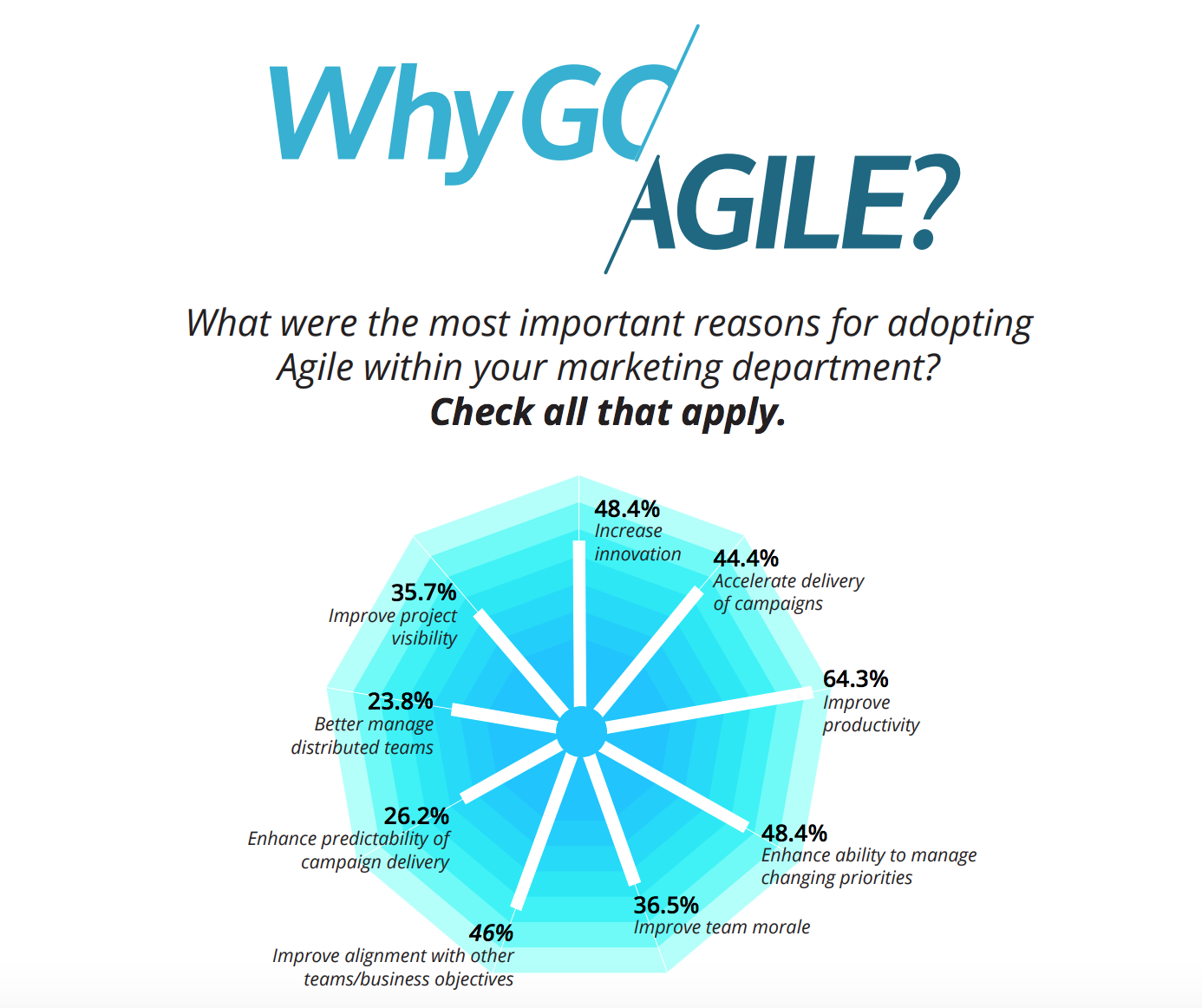What do you think of when you hear the term “agile”?
Speed? Yeah, me too.
But that’s not what the 1st State of Agile Marketing 2018 research found as the top goal, priority, or outcome.
Speed came in fifth as a driver for marketers who have taken the plunge into agile marketing. I have to say I find this a bit of a relief. If you’re not careful, speed can be a booby trap that leaves your content starved for meaning, purpose, and resonance. Who in marketing isn’t familiar with the age-old Quantity vs. Quality debate, even as topics become saturated by the swift deployment of content, much of which sits unread.
Get the entire 1st Annual State of Agile Marketing Report here.
What Marketers Set as Goals When Choosing to Adopt Agile Marketing
The survey asked marketers whose teams have already gone Agile (36.7% of 692 respondents) what made them switch:

While you could argue that improving productivity is speed related, there are also other factors at play, such as collaboration, workflows, project management, and more. The most compelling reasons I find are innovation, enhancing the ability to manage changing priorities, and improving alignment with other teams and business objectives. Those are critical tactics marketers need to strengthen to have their departments seen as growth drivers rather than cost centers. Done well, they relate to our customers and markets first and our organizations second.
What Marketers Prioritize for Their Teams
When asked to rate the priorities for their marketing departments, the top five for all marketers (Agile, Traditional, and Ad hoc) include:
- Producing higher quality work: 53.3%
- Prioritizing the most important work: 44.8%
- Better alignment with organizational goals and objectives: 44.4%
- Increased productivity: 39.5%
- Ability to change gears in response to feedback: 35.9%
I’m very glad to see the emphasis on quality work. Just as significant is the prioritization of the most important work. Allowing marketers a way to say “no” to random acts of content is an imperative for a productive and effective marketing team. There are, after all, only so many hours in a Sprint…um, day.
The top two priorities also set marketers up to achieve their third priority. Aligning the work we do with our company’s business objectives is the only way to earn the respect that brings a seat at the executive table. Given the growth in importance of customer experience—and marketing’s growing responsibility for it—this alignment is imperative. There are a lot of forecasts coming along that say the biggest source of competitive differentiation will come from a company’s ability to provide a valuable, satisfying customer experience—even ahead of the product they offer.
What Marketers Get from Agile Marketing
We’ve looked at what made marketers choose Agile and how they define their top priorities, now let’s look at what Agile marketing did for them:
- Ability to change gears quickly and effectively based on feedback: 54.8%
- Goal: Enhance ability to manage changing priorities: 48.4%
- Priority: Ability to change gears in response to feedback: 35.9%
Our buyers are changing quickly—and so are their expectations. Our companies must adapt to match, which means our marketing must change in step. As buyers become more empowered, so must marketers. Unfortunately, the survey also found that it was the larger companies that had tended toward the adoption of Agile marketing.
Let’s hope this report will help the 40.3% of marketers holding fast to the status quo, traditional style of marketing and the 18.4% of ad hoc teams to take another look—this time seriously at the upside od Agile. It also doesn’t hurt that nearly 81% of Agile marketers are satisfied with how their teams manage work, compared to 44% of traditional marketers and 27% of ad hoc teams.
- Better visibility into project status: 51.6%
- Goal: Improve project visibility: 35.7%
- Priority: None
While this outcome doesn’t align exactly to a priority, the growth in use of content operations platforms that provide this outcome shows that visibility is an important prerequisite for achieving other priorities.
- Higher quality work: 46.8%
- Goal: None
- Priority: Producing higher quality work: 53.3%
I find it interesting that higher quality work wasn’t a goal that drove teams to Agile marketing but that it’s a top-three outcome. The other interesting finding from the survey is that the drive for higher quality work also appears to be predicated on mindset. When the breakdown for marketers who prioritized higher quality work is assessed, 68.3% of Agile marketers prioritized it compared to 46.3% of traditional teams and 44.6% of ad hoc teams.
While growth in the adoption of Agile marketing is happening and more traditional—and a few ad hoc—teams are planning to come on board, this study shows how hard it is to reap sweeping impact to several top priorities. I hope this is indicative of a nascent practice that will need a bit of time to reach maturity.
More effective prioritization of work was achieved by only 31.7%, the actualization of more productive teams by 37.3%, and better alignment on business objectives by 38.9%. This is a solid start and it’s my hope that we’ll see these outcomes grow in next year’s report.
Overall, the 2018 1st State of Agile Marketing Report shows marketers are making progress. Perhaps even more exciting, the report finally puts to rest the speculation about the outcomes Agile bring to help marketing teams become more valuable assets to their companies whose dependence on their effectiveness will only continue to grow.

